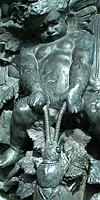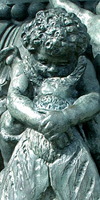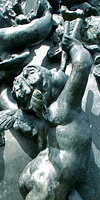Photo Corners headlinesarchivemikepasini.com
![]()
A S C R A P B O O K O F S O L U T I O N S F O R T H E P H O T O G R A P H E R
![]()
Reviews of photography products that enhance the enjoyment of taking pictures. Published frequently but irregularly.
The Three Angels of Exposure


18 December 2012
If you look for them, they aren't hard to find. Angels, that is.
No, they don't exist, but they're easy to find (especially on this site). You don't even have to look if you're talking about your own personal guardian angel. Those angels just lurk. All the time.
If you've been wary (let's say) of using Manual mode on your camera, you might be interested to learn there are a few angels lurking there, too. We like to think of them as the Three Angels of Exposure.
When you take a photo in any other mode, three of them are doing a bit more than lurking, actually. They're flapping their virtual wings like mad for a brief fraction of section so you get the right exposure.
EXPOSURE
So what is an exposure, let alone the "right" exposure? Well, let's hit our Bookshelf of the Classics to see what we can find out.
May as well start with Ansel Adams. He discussed this in his seminal work The Negative:
The term exposure requires a definition. As our discussion of apertures and shutter speeds indicated, we can give equivalent total exposure to the film using relatively high intensity of light for a short time, or less intense light for a longer duration.
That reference to film, though, obscures one of the factors the digital photographer can put into play. In his book Practical Artistry: Light & Exposure for Digital Photographers, Harold Davis explains:
The exposure equation is another way of saying that the light reflected by a scene towards a camera is captured at a given dynamic intensity by shutter speed combined with aperture and sensitivity.
So there are three settings to control the amount of light you capture. Both Adams and Davis express the relationship among them as an equation. But you didn't come here for equations.
You came for angels.

Depth Angel
THE DEPTH ANGEL
If you set the Mode dial to A for Aperture Priority, you can have a private seance with the Depth Angel.
The Depth Angel has a lot of influence over how deep focus goes in your image. It doesn't get the only vote. The focal length of the lens (wide angle or zoom, say) plays a role, as does the size of the sensor (smaller sensors on digicams and smartphones can't offer the same options as larger sensors on dSLRs) and the subject distance (focus is always shallower close up).
But with any particular sensor at any particular focal length, the Depth Angel can expand focus with a smaller aperture (indicated by a larger f-stop) or contract it with a larger aperture.
So when you set the Mode dial to A, you are expanding or contracting focus as you adjust the aperture.
Higher end cameras have a Depth of Field button which, when pressed, lets you dimly detect that range of focus. Otherwise, you can study your exposure on the LCD to see what is in focus and what's not.
There are times you want a shallow depth of focus to help the viewer see what matters in the image. And there are times you want as much of the image as possible to look sharp, say in a landscape. It's an artistic decision.
And artistic decisions need an angel.

Blur Angel
THE BLUR ANGEL
Once upon a time, cameras came with an Auto mode and either an Aperture Priority mode or -- rarely -- a Shutter Priority mode. But not both.
You bought a Shutter Priority mode camera if you were into sports.
That's because the Blur Angel handles the shutter speed. If you wanted to avoid see nothing but a blur running by you on the field, you would tell the Blur Angel to use a fast shutter.
But if you wanted to show water moving in a riverbed under the moonlight, you'd tell it to slow the shutter way way down. That water would blur as it moved and you'd have a very evocative shot.
If nothing is moving in the scene, though, it won't make a lot of difference except to limit or expand the choices the Depth Angel can make. A very fast shutter speed, indicated by a small fraction (like 1/500 second) means the lens has to be more open than a very low shutter speed (like 1/30 second).

Quality Angel
THE QUALITY ANGEL
The third angel is often neglected. In the film era, the Quality Angel was, like that clown Jack, in the box. You picked a film speed, you got that quality. The faster the film, the grainier the image and the fewer tones you could capture. The slowest films rendered the smoothest images with the most tones.
But these days the Quality Angel can adjust sensitivity on the fly, changing it from image to image. You can give orders if you want, setting sensitivity to a particular ISO value. Or you can allow the angel a little leeway and set a range of acceptable values. Or you can let the angel have free reign and set whatever ISO keeps the shutter speed hand-holdable within the limits of the lens aperture.
So even with the often ignored Quality Angel you have some very useful options.
A CHOIR OF ANGELS
These three angels work together with your exposure meter to make sure the light you capture is adequate. But that's not quite the same thing as getting the right exposure.
You can, for example, et the Mode dial to Program and let the Depth and Blur Angels pick something safe for the Quality Angel's setting. You won't be controlling depth, blur or quality if you do, though.
In Manual mode, you can use the command dials on your camera to tell the Depth Angel just how deep focus should be and the Blur Angel whether there's any motion to stop or exaggerate. And you can always confide in the Quality Angel, no matter what you've set the Mode dial to.
You just have to keep an eye on the exposure meter, asking yourself if this is a dark scene or a light scene or a well-lit scene. For a dark scene, you underexposure a bit either with the Depth Angel or the Blur Angel, depending on what's important in the scene. For a light scene, you overexposure.
You'll find the three angels work well in concert. In fact, under your direction, they can perform like a heavenly choir. So take the leap, trust in the exposure angels and give Manual mode a try.
And try not to think about the little devils hiding in your printer.